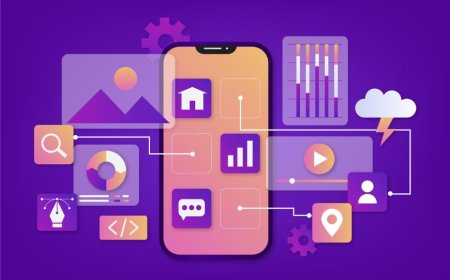How to Integrate APIs into Your Software Systems?
Get ready to take your software to the next level! Explore the world of API integration with Tectoks; learn its importance, steps, and tips for optimal software functionality.

Table of Content:
I. Overview
II. Choosing the Right APIs
III. Steps to Integrate APIs into Your Software
IV. Best Practices for API Integration
V. Conclusion
Imagine you're at a restaurant. You're the customer (like a user of an app or website), and the kitchen is the server (like a computer or a system that stores and processes data).
Now, let's say you want to order food. You don't go into the kitchen and start cooking yourself. Instead, you talk to the waiter (like an API) and tell them what you want. The waiter then takes your order to the kitchen, where the chefs (like the software or system) prepare your food.
In this scenario:
1. You (the customer) represent a user or client of a service, like an app or website.
2. The waiter (the API) acts as a middleman between you and the kitchen (the server or system that holds the data or performs tasks).
3. The kitchen (the server or system) is where the actual work gets done, such as retrieving information or performing actions.
So, in simple terms, an API (Application Programming Interface) is like a waiter that takes your requests (like ordering food) and communicates them to the system or server to get things done for you. It makes it easier for different software or systems to talk to each other and work together smoothly, just like the waiter helps you get your food without you needing to enter the kitchen yourself. In this guide, we'll demystify API integration, covering its meaning, importance, practical steps, and best practices. Whether you're a developer seeking to enhance functionality or a business owner aiming for efficiency, join us as we unlock the power of API integration in a clear, concise manner. Let's dive in and transform your software's capabilities together.
I. Overview
In today's interconnected digital landscape, Application Programming Interfaces (APIs) play a pivotal role in enabling seamless communication and integration between different software systems. Whether you're building a web application, mobile app, or enterprise software, understanding how to effectively integrate APIs into your software is crucial for success.
What are APIs?
At its core, an API is a set of rules and protocols that allows different software applications to communicate with each other. It serves as an intermediary that enables the exchange of data and functionality between disparate systems, essentially acting as a bridge between them.
Types of APIs
There are various types of APIs, each with its own set of protocols and conventions. Some of the most common types include:
- RESTful APIs: Representational State Transfer (REST) APIs are based on a client-server architecture and rely on standard HTTP methods (GET, POST, PUT, DELETE) for communication. They use uniform resource identifiers (URIs) to access and manipulate resources.
- SOAP APIs: Simple Object Access Protocol (SOAP) APIs are a protocol for exchanging structured information in the implementation of web services. They use XML for message formatting and typically operate over HTTP or SMTP.
- GraphQL: GraphQL is a query language for APIs and a runtime for executing those queries with existing data. It provides a more flexible and efficient approach to data retrieval by allowing clients to specify exactly what data they need.
Importance of API Integration
The integration of APIs into software applications offers several key benefits:
- Enhanced Functionality: By leveraging external APIs, developers can augment the capabilities of their software without having to build everything from scratch.
- Time and Cost Efficiency: API integration accelerates development cycles by reducing the need to reinvent the wheel. It allows developers to focus on core functionality while outsourcing specialized features to third-party services.
- Scalability and Flexibility: APIs facilitate modular development, enabling software systems to scale more efficiently and adapt to changing requirements over time.
How APIs Work?
APIs function by exposing a set of endpoints that define the operations available for interaction. These endpoints typically correspond to specific actions or resources within the software system. When a client application makes a request to an API endpoint, the server processes the request and returns a response containing the requested data or performing the specified operation.
Benefits of Integrating APIs into Software
Integrating APIs into your software unlocks a myriad of benefits, including:
- Access to Specialized Services: APIs allow you to tap into specialized services and functionalities offered by third-party providers, such as payment gateways, mapping services, or social media platforms.
- Improved User Experience: By integrating with external APIs, you can enrich the user experience by incorporating features and data sources that would otherwise be inaccessible or time-consuming to develop independently.
- Interoperability and Interconnectivity: APIs facilitate interoperability between different software systems, enabling seamless data exchange and collaboration across disparate platforms.
II. Choosing the Right APIs
Before embarking on the integration process, it's essential to choose the right APIs that align with your software's requirements and objectives. Here are some key steps to consider:
Identifying Your Software Requirements
Start by clearly defining the functionality and features you want to incorporate into your software. Identify any gaps in your application's capabilities that could be addressed through API integration.
Researching Available APIs
Once you've identified your requirements, research available APIs that offer the desired functionality. Explore reputable API marketplaces and directories, such as RapidAPI, ProgrammableWeb, or GitHub, to discover relevant APIs within your niche.
Evaluating API Documentation and Support
When evaluating potential APIs, pay close attention to the quality and comprehensiveness of their documentation. Well-documented APIs provide clear instructions and examples for integration, reducing the learning curve for developers. Additionally, assess the level of developer support offered by the API provider, including forums, documentation updates, and technical assistance channels.
III. Steps to Integrate APIs into Your Software
Integrating APIs into your software involves a series of systematic steps to ensure seamless communication and functionality. Here's a comprehensive guide to the integration process:
A. Planning the Integration
Before diving into implementation, take the time to plan your API integration strategy:
Defining Integration Goals: Clearly define the objectives and outcomes you aim to achieve through API integration. Whether it's enhancing functionality, improving user experience, or streamlining business processes, having clear goals will guide your integration efforts.
Assessing Potential Impact on Existing Codebase: Evaluate how integrating APIs will impact your existing codebase and infrastructure. Consider factors such as compatibility, performance, and scalability to minimize disruptions during the integration process.
B. API Authentication and Access
API authentication is a critical aspect of integration, ensuring secure access to protected resources. Here's what you need to know:
Understanding Authentication Methods: Familiarize yourself with different authentication methods supported by the API, such as API keys, OAuth, or token-based authentication. Choose the method that best aligns with your security requirements and workflow.
Obtaining Necessary Credentials: Obtain the necessary credentials (e.g., API keys, client IDs, client secrets) from the API provider to authenticate your requests. Follow best practices for storing and managing these credentials securely to prevent unauthorized access.
C. API Integration Implementation
Once you have the necessary credentials, it's time to implement the API integration:
Using SDKs or Libraries: Many APIs provide Software Development Kits (SDKs) or client libraries to simplify integration with popular programming languages and frameworks. Utilize these resources to expedite the integration process and handle common tasks, such as request serialization and response parsing.
Making API Requests: Use HTTP methods (GET, POST, PUT, DELETE) to interact with the API endpoints and perform desired actions, such as retrieving data, submitting forms, or updating resources. Construct API requests following the specifications outlined in the documentation, including endpoint URLs, request parameters, and headers.
Handling Responses and Errors: Process API responses and handle errors gracefully within your application. Implement error handling mechanisms to detect and respond to common error scenarios, such as invalid requests, rate limiting, or server errors. Consider implementing retry strategies and exponential backoff to handle transient failures.
D. Testing
Thorough testing is essential to ensure the reliability and functionality of your API integration:
Unit Testing API Requests and Responses: Write unit tests to validate individual API requests and responses, covering various scenarios and edge cases. Mock external dependencies and responses to isolate API interactions and facilitate faster, more predictable testing.
Integration Testing with Mock Data: Conduct integration tests to validate end-to-end functionality and data flow within your application. Use mock data or sandbox environments provided by the API provider to simulate real-world scenarios and interactions. Verify that API integrations perform as expected under different conditions, including network latency, data variability, and error handling.
E. Deployment
Once testing is complete, deploy your changes to the production environment:
Deploying Changes to Production Environment: Follow your organization's deployment procedures and best practices to deploy API integrations safely and efficiently. Ensure that all necessary configurations, credentials, and dependencies are properly configured and secured in the production environment.
Monitoring API Usage and Performance: Implement monitoring and logging mechanisms to track API usage, performance metrics, and error rates in real-time. Set up alerts and notifications to proactively identify issues and anomalies, enabling timely intervention and troubleshooting.
IV. Best Practices for API Integration
To ensure the success and sustainability of your API integrations, adhere to best practices throughout the development lifecycle:
Keeping API Keys Secure: Safeguard API keys and credentials using secure storage mechanisms, such as environment variables, encrypted configuration files, or key management services. Avoid hardcoding sensitive information in source code repositories or exposing them publicly.
Implementing Proper Error Handling: Develop robust error handling mechanisms to gracefully handle unexpected scenarios and failures during API interactions. Provide informative error messages and feedback to users, guiding them on how to resolve issues or recover from errors effectively.
Versioning APIs: Stay abreast of API version updates and changes introduced by the API provider. Adhere to versioning best practices to ensure backward compatibility and minimize disruptions for existing integrations. Consider implementing versioning strategies, such as semantic versioning or API versioning in endpoint URLs, to manage changes systematically.
Documenting Integration Processes: Maintain comprehensive documentation for your API integrations, including setup instructions, usage guidelines, and troubleshooting resources. Document key integration decisions, configurations, and dependencies to facilitate knowledge sharing and onboarding for future development efforts.
V. Conclusion
In conclusion, integrating APIs into your software empowers you to leverage external services, enhance functionality, and deliver superior user experiences. By following best practices and adopting a systematic approach to integration, you can unlock the full potential of APIs and drive innovation in your software applications. Remember to prioritize ongoing maintenance, monitoring, and updates to ensure the longevity and reliability of your API integrations. Embrace a culture of continuous learning and exploration to stay current with evolving technologies and opportunities in the API landscape. Start integrating APIs into your software today and embark on a journey of endless possibilities.
With the right approach and mindset, API integration can propel your software to new heights of success and innovation. Harness the power of APIs to unlock new capabilities, streamline workflows, and delight users with seamless, interconnected experiences.
What's Your Reaction?











































































